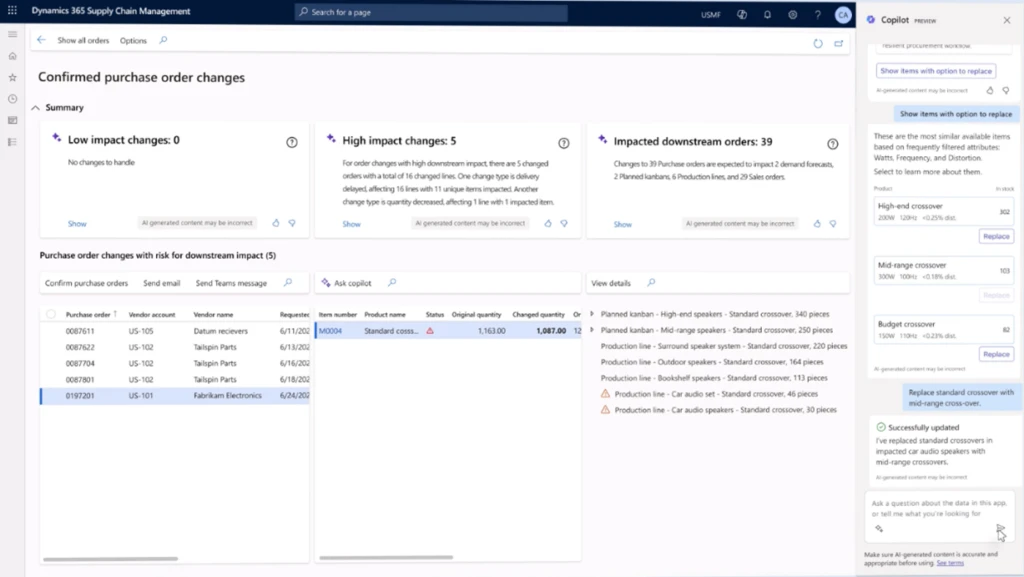
Shaping the future of retail with AI and Dynamics 365
This article is contributed. See the original author and article here.
In an industry defined by both growth and disruption, retailers are depending on technology to navigate challenges ranging from shifting purchase habits to supply chain complexities. Next week, at the National Retail Federation (NRF) Big Show, Microsoft will demonstrate Dynamics 365 solutions powered by AI to help accelerate retail agility and innovation in the next decade.

Gain valuable AI insights for your business
Learn more at the National Retail Federation Big Show
In addition to solutions powered by Microsoft Cloud for Retail, this vision for the future of retail is spotlighted by new Copilot capabilities for Dynamics 365 applications, including:
- Microsoft Dynamics 365 Customer Insights, providing retailers with AI-powered experiences to transform daily marketing workflows.
- Microsoft Dynamics 365 Supply Chain Management, providing AI
NRF attendees can learn more about the transformative power of AI across the retail industry by attending two Big Ideas Sessions hosted by Shelley Bransten, Corporate Vice President, Global Retail, Consumer Goods, and Gaming Industries, and Kathleen Mitford, Corporate Vice President, Global Industry Marketing.
Helping retailers personalize the shopping experience
Retailers often tell us that they’re under pressure to get marketing and customer experience projects and campaigns to market faster and are asked to do more with less. Yet, the processes and tools they use haven’t evolved to meet this demand.
Deploying a project to market requires various roles or specialists, costly third-party agencies, and siloed applications to review data and create content. Monitoring results for optimization also becomes a timely and tedious task, having to track down the right people with the right application and the right data. These challenges not only hinder a campaign’s time to market and employee productivity, but can also result in a disjointed customer experience.
It’s not just our customers who are feeling the burden of these challenges. The market is feeling it too. For instance, 63% of surveyed retailers said they hope they can improve their marketing with AI in the next 18 to 24 months.1 In the age of AI, shouldn’t it be easier to get your campaigns to market?
We are announcing new Copilot features in Dynamics 365 Customer Insights that will transform how marketers manage and maintain projects and campaigns, increasing productivity, efficiency, and speed to market. These new capabilities build on Copilot features introduced in the past year, including, but not limited to, the ability to generate content ideas, query customer data using natural language, and create customer segments and journeys using next-generation AI.
Marketers can kick-start their marketing project by writing their campaign objective in natural language, or by uploading an existing creative brief. The project board is then generated using the prompt or brief, connected organizational data, and previous campaigns in Customer Insights. The project board streamlines and connects all workflows into one place for building and managing marketing assets.

“These new copilot capabilities in Dynamics 365 Customer Insights will enable us to focus our time and energy in the right places—better informing us on optimization priorities without the need to dig into details manually. That alone saves so much time.”
—Hannah Harper, Leatherman, Digital Marketing Manager
From the project board, marketers can view the campaign’s target audience and segments, as well as recommendations from Copilot for additional segments that may not have been previously considered. Selecting a suggested audience segment automatically generates a complementary customer journey, saving marketers time while also helping them deliver a personalized customer experience.

End-to-end customer journeys containing personalized touchpoints, such as promotional emails or event invitations, are generated using Copilot. Through our partnership with Typeface and its enterprise-grade generative AI capabilities, marketers can produce brand-authentic images across assets, supercharging personalized content for greater impact—all from within Dynamics 365 Customer Insights. Additionally, Typeface helps align content to the organization’s brand guidelines, including themes, fonts, and product images—extracted from a central asset library.
“Every aspect of the enterprise is already being redefined with generative AI, from developer to product to sales experiences. By combining Dynamics 365 Customer Insights with Typeface’s powerful storytelling engine, we’re fundamentally reshaping campaign workflows with generative AI by starting with just a goal. This means personalizing content at an unprecedented scale, bridging the gap between content and data, and ushering in a new era of marketing creativity and productivity.”
—Abhay Parasnis, Founder and CEO of Typeface
These Copilot capabilities will be available in preview in the first quarter of 2024, with general availability by the third quarter of 2024. Existing Customer Insights customers can sign up now for the early access public preview program here.
This is just the beginning; we will be delivering further content curation, journey testing, and metrics monitoring to optimize campaigns. Our vision is that, together, this new AI-first experience will transform how marketers work by reducing the complexities of end-to-end campaign management and enhancing marketer productivity and ROI.
Click the image below to watch a video and learn more about our vision.

Build a real-time retail supply chain
In 2024, retail supply chains face countless challenges, from labor shortages and increasing costs to complexities across omnichannel retail experiences. Enterprise AI solutions, now readily available for retailers, can power greater efficiency, productivity, and innovation across the supply chain.
At Microsoft, we aim to deliver new supply chain innovations powered by Copilot to our customers through our open, flexible, and collaborative Microsoft platform; helping organizations to reduce risk, manage inventory, plan with flexibility, and make quick decisions across the whole supply chain.
New copilot capabilities to improve demand planning
A retailer’s success hinges on having the right inventory at the right place at the right time, and that starts with successful demand planning. We recently announced new demand planning capabilities in Dynamics 365 in November 2023 that uses AI, machine learning, and external signals to predict demand accurately, and now we are enhancing it with Copilot. This will help planners understand how a forecast was generated and help them find patterns and anomalies.
Copilot will also help them make sense of complex relationships across datasets using natural language interactions, and it will also assist with the routine tasks of making demand review reports, saving the planners time to focus on high-priority activities.

Some of our customers, including Domino’s Pizza UK & Ireland, can use the new demand planning capabilities to make smart predictions from the data and insights.
“The demand planning capabilities in Dynamics 365 are helping us make the right decisions to lower wastage, avoid unnecessary deliveries, and be cybersafe.”
—Neha Batra, Head of Business Solutions, Domino’s Pizza UK & Ireland
The new demand planning capabilities create a more flexible, simplified, and intuitive user experience. Planners have an increased level of trust and can rely more on the forecast, knowing how it’s generated. The latest demand planning capabilities help reduce excess inventory and increase working capital for retailers.
New Copilot capabilities to improve productivity and proactively mitigate disruptions
In November 2023, we also announced new Copilot capabilities in preview for Dynamics 365 that enable supply chain teams to take actions based on insights with conversational help while in the flow of work. This helps increase productivity and improved collaboration among employees across the supply chain and other cross-functional teams to proactively mitigate disruptions and further automate their workflows. See the capabilities in action.

We also added new Copilot capabilities that will enhance inventory visibility and enable businesses to promise orders with improved accuracy, significantly helping brands elevate their consumers’ buying experience.
In addition, a new copilot capability that helps to streamline procurement is now generally available. Procurement teams can seamlessly handle the purchase order changes in a scalable and efficient manner and assess the impact of changes downstream to production and distribution before making the right decision.
Generate product enrichment content for e-commerce sites with Copilot
Informative, story-rich product content can drive customer engagement and sales on e-commerce sites. Creating that content, however, can be time-consuming and challenging. In October 2023, we launched in preview the ability for business-to-business and business-to-consumer online retailers to use Copilot in Dynamics 365 Commerce to generate enriched product marketing content for their websites. This helps to decrease the time it takes to create compelling marketing content, while increasing productivity and increasing the overall number of online orders.
Visit our Microsoft booth at NRF this year to see these innovations in action.
Discover the future of retail at NRF 2024
Learn more about Dynamics 365 solutions for the retail industry and retail solutions introduced at NRF 2024. If you are registered for NRF 2024, we invite you to stop by our booth for demos of our solution and attend the following sessions:
Retail unlocked: achieve more with Microsoft: Hosted by Shelley Bransten, Corporate Vice President, Global Retail, Consumer Goods and Gaming industries, Microsoft
Sunday, January 14, 2024 | 1:00 – 1:30 PM Eastern Standard Time (EST)
Join this interactive session to hear about one retailer’s AI journey to date. Hosted by Microsoft’s Corporate Vice President, Retail, Consumer Goods & Gaming Industries, Shelley Bransten, you’ll also learn about new AI-focused findings from Futurum Research and all new AI capabilities in Microsoft Cloud for Retail that will help power your AI transformation.
Unlocking true customer-centricity: optimizing touchpoints across the shopper journey with AI: Hosted by Kathleen Mitford, Corporate Vice President, Global Industry Marketing
Monday, January 15, 2024 | 11:45 – 12:15 PM EST
Generative AI and large language models have captured the attention of executives across industries. While the technology’s use cases seem endless, smart retailers and brands must identify and prioritize the applications of generative AI that will be most valuable to their organization and partner with organizations who will treat their data with the highest privacy standards. Join us to hear how Microsoft is helping organizations large and small maximize their generative AI opportunities safely and responsibly.
Unify your data to unlock AI opportunities: Hosted by Satish Thomas, Corporate Vice President, Microsoft Industry Clouds
Tuesday, January 16, 2024 | 1:00 – 1:45 PM EST
Retailers are swimming in data all day, every day. Even with sophisticated legacy technologies and cutting-edge data science, the majority of that data goes uncollected. Insights stay hidden—often in plain sight. But that’s starting to change. AI tools are enabling retailers to understand their customers, merchandising, supply chains, operations, and workforces better than ever before. Join us to hear about the myriad insights that retailers are drawing from newfound and increasingly precise data sources to run leaner, smarter stores.
1 AI Adoption in Retail Survey, The Futurum Group, 2024
The post Shaping the future of retail with AI and Dynamics 365 appeared first on Microsoft Dynamics 365 Blog.
Brought to you by Dr. Ware, Microsoft Office 365 Silver Partner, Charleston SC.





Recent Comments